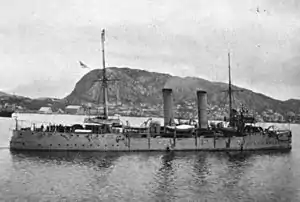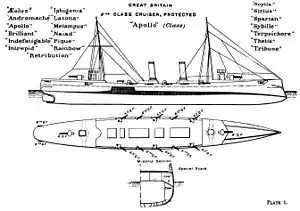Apollo-class cruiser
The Apollo class were a class of second-class protected cruisers built for the Royal Navy in the late 19th century that served during the Boer War and the First World War.
 HMS Spartan, pictured in Norwegian waters in 1904 | |
| Class overview | |
|---|---|
| Name: | Apollo class |
| Operators: | |
| Preceded by: | Pearl class |
| Succeeded by: | Astraea class |
| Built: | 1889–1892 |
| In commission: | 1889–1931 |
| Completed: | 21 |
| Lost: | 6 |
| Scrapped: | 15 |
| General characteristics | |
| Type: | Protected cruiser |
| Displacement: | 3,600 long tons (3,700 t) |
| Length: | 314 ft (96 m) |
| Beam: | 43 ft 6 in (13.26 m) |
| Draught: | 17 ft 6 in (5.33 m) |
| Speed: | 19.75 knots (22.73 mph; 36.58 km/h) |
| Complement: | 273 to 300 officers and men |
| Armament: |
|

Latona, Apollo, Intrepid, Iphigenia, Andromache, Naiad and Thetis were converted into minelaying cruisers around 1907.
Service
Twenty-one of the Apollo class of second-class cruisers were built under the 1889 Naval Defence Act, along with eight to a modified design (the Astraea class).
By the last year of the First World War, the surviving ships were outdated, and six of this class were converted into blockships to be scuttled in the entrances to enemy-occupied ports in Belgium. The cruisers Intrepid, Iphigenia and Thetis were expended on 23 April 1918 in the raid on Zeebrugge; Brilliant and Sirius were unsuccessfully expended in the similar raid on Ostend. A further attempt to block Ostend took place in May, with Sappho and Vindictive (the latter being of the Arrogant class) as blockships, but Sappho broke down en route to Ostend and returned to port.
Ships
| Name | Builder | Laid down | Launched | Completed | Fate | |||
|---|---|---|---|---|---|---|---|---|
| Andromache | Chatham Dockyard | 29 April 1889 | 14 August 1890 | December 1891 | Broken up in 1920 | |||
| Apollo | Chatham Dockyard | 27 May 1889 | 10 February 1891 | April 1892 | Broken up in 1920 | |||
| Latona | Vickers, Barrow-in-Furness |
22 August 1889 | 22 May 1890 | April 1891 | Sold in 1920 | |||
| Melampus | Vickers, Barrow-in-Furness |
30 August 1889 | 2 August 1890 | December 1891 | Broken up in 1910 | |||
| Naiad | Vickers, Barrow-in-Furness |
3 October 1889 | 29 November 1890 | January 1892 | Broken up in 1922 | |||
| Sappho | Samuda Brothers, Poplar | 29 October 1889 | 9 May 1891 | February 1893 | Broken up in 1921 | |||
| Scylla | Samuda Brothers, Poplar | 29 October 1889 | 17 October 1891 | April 1893 | Broken up in 1914 | |||
| Sybille | Robert Stephenson, Hebburn | 11 October 1889 | 27 December 1890 | May 1894 | Wrecked in 1901 | |||
| Terpsichore | J & G Thomson, Clydebank | 27 August 1889 | 30 October 1890 | April 1892 | Broken up in 1914 | |||
| Thetis | J & G Thomson, Clydebank | 29 October 1889 | 13 December 1890 | April 1892 | Expended as blockship in 1918 | |||
| Tribune | J & G Thomson, Clydebank | 11 December 1889 | 24 February 1891 | May 1892 | Broken up in 1911 | |||
| Aeolus | Devonport Dockyard | 19 March 1890 | 13 November 1891 | June 1893 | Broken up in 1914 | |||
| Brilliant | Sheerness Dockyard | 24 March 1890 | 24 June 1891 | April 1893 | Expended as blockship in 1918 | |||
| Indefatigable | London & Glasgow | 6 September 1889 | 12 March 1891 | April 1892 | Broken up in 1913 | |||
| Intrepid | London & Glasgow | 6 September 1889 | 20 June 1891 | November 1892 | Expended as blockship in 1918 | |||
| Iphigenia | London & Glasgow | 17 March 1890 | 19 November 1891 | May 1893 | Expended as blockship in 1918 | |||
| Pique | Palmers, Jarrow | 30 October 1889 | 13 December 1890 | March 1893 | Broken up in 1911 | |||
| Rainbow | Palmers, Jarrow | 30 December 1889 | 25 March 1891 | January 1893 | 1910 to Royal Canadian Navy as HMCS Rainbow. Sold in 1920 | |||
| Retribution | Palmers, Jarrow | 31 January 1890 | 6 August 1891 | May 1893 | Broken up in 1911 | |||
| Sirius | Armstrong Mitchell, Elswick | 7 October 1889 | 27 October 1890 | April 1892 | Expended as blockship in 1918 | |||
| Spartan | Armstrong Mitchell, Elswick | 16 December 1889 | 25 February 1891 | July 1892 | Broken up in 1931 | |||
| Sources: Conway's 1860–1905, p. 77; Jane's, p. 62 | ||||||||
Notes
- Scott, Percy (1919). Fifty Years in the Royal Navy. London: John Murray. pp. 88.
Publications
- Colledge, J. J.; Warlow, Ben (2006) [1969]. Ships of the Royal Navy: The Complete Record of all Fighting Ships of the Royal Navy (Rev. ed.). London: Chatham Publishing. ISBN 978-1-86176-281-8.